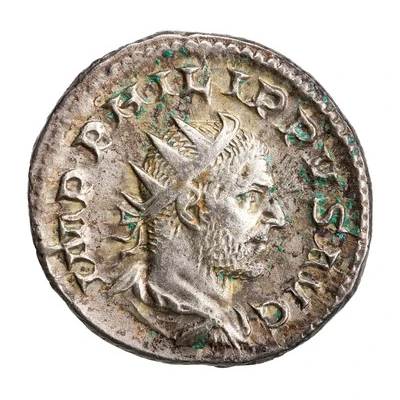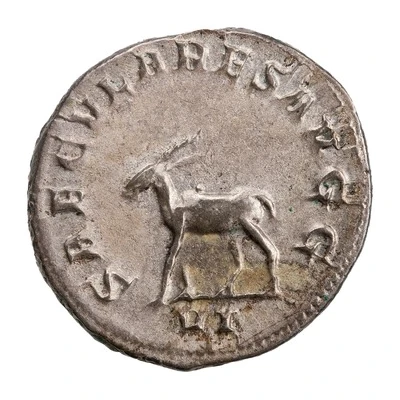


© American Numismatic Society (ANS)
Antoninianus - Philippus I SAECVLARES AVGG
248 year| Silver | 4 g | 22.5 mm |
| Issuer | Rome › Roman Empire (27 BC - 395 AD) |
|---|---|
| Emperor | Philip I (Marcus Iulius Philippus) (244-249) |
| Type | Standard circulation coin |
| Year | 248 |
| Value | Antoninianus (1) |
| Currency | Antoninianus, Reform of Caracalla (AD 215 – 301) |
| Composition | Silver |
| Weight | 4 g |
| Diameter | 22.5 mm |
| Shape | Round (irregular) |
| Technique | Hammered |
| Orientation | Variable alignment ↺ |
| Demonetized | Yes |
| Updated | 2024-10-05 |
| Numista | N#282074 |
|---|---|
| Rarity index | 90% |
Reverse
Antelope, walking left.
Script: Latin
Lettering: SAECVLARES AVGG
Translation:
Saeculares Duorum Augustorum.
Secular Games of the two emperors (Augusti).
Comment
Mass varies: 3.2–4.82 g;Diameter varies: 21.5–24.2 mm;
Example of this type:
American Numismatic Society (ANS)
Source:
Online Coins of the Roman Empire (OCRE)
Interesting fact
The Antoninianus coin, which was issued during the reign of Philippus I (244-249 AD), was a significant departure from previous Roman coins in terms of its design and metallic composition. It was the first Roman coin to feature a radiate crown on the obverse (front side), which was meant to symbolize the emperor's divine nature and connection to the sun god Sol Invictus. Additionally, the coin was made of silver, which was a departure from the traditional bronze or copper used in previous coins. This change in material was likely due to the devaluation of the Roman currency at the time, which had led to a shortage of precious metals like silver. Despite these changes, the Antoninianus coin remained a widely used and influential coin throughout the Roman Empire.